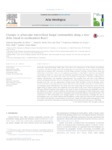Use este identificador para citar ou linkar para este item:
http://www.alice.cnptia.embrapa.br/alice/handle/doc/1063083Registro completo de metadados
| Campo DC | Valor | Idioma |
|---|---|---|
| dc.contributor.author | SILVA, I. R. da | pt_BR |
| dc.contributor.author | SILVA, D. K. A. da | pt_BR |
| dc.contributor.author | SOUZA, F. A. de | pt_BR |
| dc.contributor.author | OEHLD, F | pt_BR |
| dc.contributor.author | MAIA, L. C. | pt_BR |
| dc.date.accessioned | 2017-06-06T23:54:46Z | - |
| dc.date.available | 2017-06-06T23:54:46Z | - |
| dc.date.created | 2017-02-08 | pt_BR |
| dc.date.issued | 2017 | pt_BR |
| dc.identifier.citation | Acta Oecologica, Paris, v. 79, p. 8-17, 2017. | pt_BR |
| dc.identifier.uri | http://www.alice.cnptia.embrapa.br/alice/handle/doc/1063083 | pt_BR |
| dc.description | Arbuscular mycorrhizal fungi (AMF) play a key role in the maintenance of the balance of terrestrial ecosystems, but little is known about the biogeography of these fungi, especially on tropical islands. This study aims to compare AMF community structure along a transect crossing a fluvial-marine island and relate these communities with soil and vegetation parameters to shed light on the forces driving AMF community structure on a local scale. We tested the hypothesis that the composition of AMF communities changes across the island, even within short distances among sites, in response to differences in edaphic characteristics and vegetation physiognomies. We sampled roots and soils in five different natural and degraded habitats: preserved mangrove forest (MF), degraded mangrove forest (MD), natural Restinga forest (RF), and two regeneration Restinga forests (RR1 and RR2) on Ilha da Restinga, northeastern Brazil. We determined the mycorrhizal colonization rate and AMF community structure based on morphological spore identification. The island soils were sandy with pH varying from acid to neutral; higher levels of organic matter were registered in RF and lower in MF; other chemical and physical soil attributes differed along the habitat types on the island. In total, 22 AMF species were identified, without any difference in species richness. However, the diversity and composition of AMF communities, spore abundance per families, and mycorrhizal colonization were statistically different among the habitats. The composition of AMF communities was strongly related to soil characteristics, especially the sum of exchangeable bases. Our results indicate that the different habitat types have diverse AMF communities even within short distances among habitats. In conclusion, islands with high spatial heterogeneity in soil parameters and diverse vegetation are potential refuges for the diversity conservation of AM fungi. | pt_BR |
| dc.language.iso | eng | eng |
| dc.rights | openAccess | eng |
| dc.title | Changes in arbuscular mycorrhizal fungal communities along a river delta island in northeastern Brazil. | pt_BR |
| dc.type | Artigo de periódico | pt_BR |
| dc.date.updated | 2017-11-17T11:11:11Z | pt_BR |
| dc.subject.thesagro | Micorriza | pt_BR |
| riaa.ainfo.id | 1063083 | pt_BR |
| riaa.ainfo.lastupdate | 2017-11-17 -02:00:00 | pt_BR |
| dc.identifier.doi | 10.1016/j.actao.2016.12.011 | pt_BR |
| dc.contributor.institution | Iolanda Ramalho da Silva, Universidade Federal de Pernambuco; Danielle Karla Alves da Silva, Universidade Federal do Vale do São Francisco; FRANCISCO ADRIANO DE SOUZA, CNPMS; Fritz Oehld, Agroscope, Ecotoxicology, Schloss; Leonor Costa Maia, Universidade Federal de Pernambuco. | pt_BR |
| Aparece nas coleções: | Artigo em periódico indexado (CNPMS)  | |
Arquivos associados a este item:
| Arquivo | Descrição | Tamanho | Formato | |
|---|---|---|---|---|
| Changesarbuscular.pdf | 1,16 MB | Adobe PDF |  Visualizar/Abrir |









